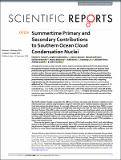| dc.contributor.author | Fossum, Kirsten N. | |
| dc.contributor.author | Ovadnevaite, Jurgita | |
| dc.contributor.author | Ceburnis, Darius | |
| dc.contributor.author | Dall'Osto, Manuel | |
| dc.contributor.author | Marullo, Salvatore | |
| dc.contributor.author | Bellacicco, Marco | |
| dc.contributor.author | Simó, Rafel | |
| dc.contributor.author | Liu, Dantong | |
| dc.contributor.author | Flynn, Michael | |
| dc.contributor.author | Zuend, Andreas | |
| dc.contributor.author | O'Dowd, Colin | |
| dc.date.accessioned | 2020-06-19T07:30:11Z | |
| dc.date.available | 2020-06-19T07:30:11Z | |
| dc.date.issued | 2019-07-18 | |
| dc.identifier.citation | Fossum, Kirsten N., Ovadnevaite, Jurgita, Ceburnis, Darius, Dall’Osto, Manuel, Marullo, Salvatore, Bellacicco, Marco, Simó, Rafel Liu, Dantong, Flynn, Michael, Zuend, Andreas, O’Dowd, Colin. (2019). Summertime Primary and Secondary Contributions to Southern Ocean Cloud Condensation Nuclei. Scientific Reports, 9(1), 10613. doi:10.1038/s41598-019-46788-3 | en_IE |
| dc.identifier.issn | 2045-2322 | |
| dc.identifier.uri | http://hdl.handle.net/10379/16038 | |
| dc.description.abstract | Atmospheric aerosols in clean remote oceanic regions contribute significantly to the global albedo through the formation of haze and cloud layers; however, the relative importance of ‘primary’ wind-produced sea-spray over secondary (gas-to-particle conversion) sulphate in forming marine clouds remains unclear. Here we report on marine aerosols (PM1) over the Southern Ocean around Antarctica, in terms of their physical, chemical, and cloud droplet activation properties. Two predominant pristine air masses and aerosol populations were encountered: modified continental Antarctic (cAA) comprising predominantly sulphate with minimal sea-salt contribution and maritime Polar (mP) comprising sulphate plus sea-salt. We estimate that in cAA air, 75% of the CCN are activated into cloud droplets while in mP air, 37% are activated into droplets, for corresponding peak supersaturation ranges of 0.37–0.45% and 0.19–0.31%, respectively. When realistic marine boundary layer cloud supersaturations are considered (e.g. ~0.2–0.3%), sea-salt CCN contributed 2–13% of the activated nuclei in the cAA air and 8–51% for the marine air for surface-level wind speed < 16 m s−1. At higher wind speeds, primary marine aerosol can even contribute up to 100% of the activated CCN, for corresponding peak supersaturations as high as 0.32%. | en_IE |
| dc.description.sponsorship | The research leading to these results has received funding from the European Union’s Seventh Framework Programme (FP7/2007-2013) project BACCHUS under grant agreement n_ 603445; Spanish Ministry of Economy and Competitiveness (MINECO) as part of the PEGASO (Ref.: CTM2012-37615) and BIO-NUC (Ref: CGL2013-49020-R) projects; HEA-PRTLI4 and SFI under MaREI. EPA Ireland is acknowledged for research support at Mace Head. M.B. received funding through the Italian RITMARE fellowship and is now funded by the postdoc fellowship of the Centre National d'Études Spatiales (CNES, Paris, France). A.Z. acknowledges support by the Natural Sciences and Engineering Research Council of Canada (NSERC), through grant RGPIN/04315-2014. The SP2 instrument used in this work was provided by H. Coe and J. Allan from the Centre for Atmospheric Sciences, School of Earth and Environmental Sciences, University of Manchester, Manchester M13 9PL, UK. We acknowledge the use of imagery from the NASA Worldview application (https://worldview.earthdata.nasa.gov/) operated by the NASA/Goddard Space Flight Center Earth Science Data and Information System (ESDIS) project. | en_IE |
| dc.format | application/pdf | en_IE |
| dc.language.iso | en | en_IE |
| dc.publisher | Nature Research (part of Springer Nature) | en_IE |
| dc.relation.ispartof | Scientific Reports | en |
| dc.rights | Attribution-NonCommercial-NoDerivs 3.0 Ireland | |
| dc.rights.uri | https://creativecommons.org/licenses/by-nc-nd/3.0/ie/ | |
| dc.subject | Peak Supersaturation | en_IE |
| dc.subject | Aerosol | en_IE |
| dc.subject | Population | en_IE |
| dc.subject | Cloud | en_IE |
| dc.subject | Droplets | en_IE |
| dc.subject | Scanning | en_IE |
| dc.subject | Scanning Mobility Particle Sizer (SMPS) | en_IE |
| dc.subject | Aitken Mode | en_IE |
| dc.title | Summertime primary and secondary contributions to Southern Ocean cloud condensation nuclei | en_IE |
| dc.type | Article | en_IE |
| dc.date.updated | 2020-06-18T12:27:21Z | |
| dc.identifier.doi | 10.1038/s41598-019-46788-3 | |
| dc.local.publishedsource | https://doi.org/10.1038/s41598-018-32047-4 | en_IE |
| dc.description.peer-reviewed | peer-reviewed | |
| dc.contributor.funder | Seventh Framework Programme | en_IE |
| dc.contributor.funder | Spanish Ministry of Economy and Competitiveness (MINECO) | en_IE |
| dc.contributor.funder | Science Foundation Ireland | en_IE |
| dc.internal.rssid | 19116749 | |
| dc.local.contact | Darius Ceburnis, University Road, School Of Physics, Nui Galway, Room Phy229 , Arts/Science Building. 2496 Email: darius.ceburnis@nuigalway.ie | |
| dc.local.copyrightchecked | Yes | |
| dc.local.version | PUBLISHED | |
| dcterms.project | info:eu-repo/grantAgreement/EC/FP7::SP1::ENV/603445/EU/Impact of Biogenic versus Anthropogenic emissions on Clouds and Climate: towards a Holistic UnderStanding/BACCHUS | en_IE |
| nui.item.downloads | 130 | |


